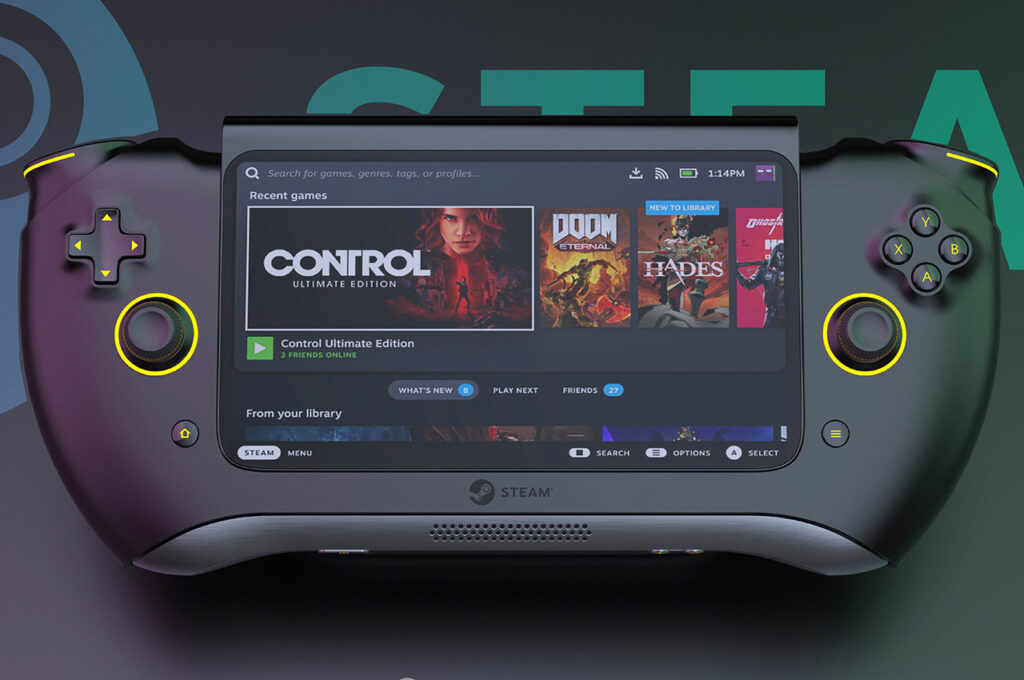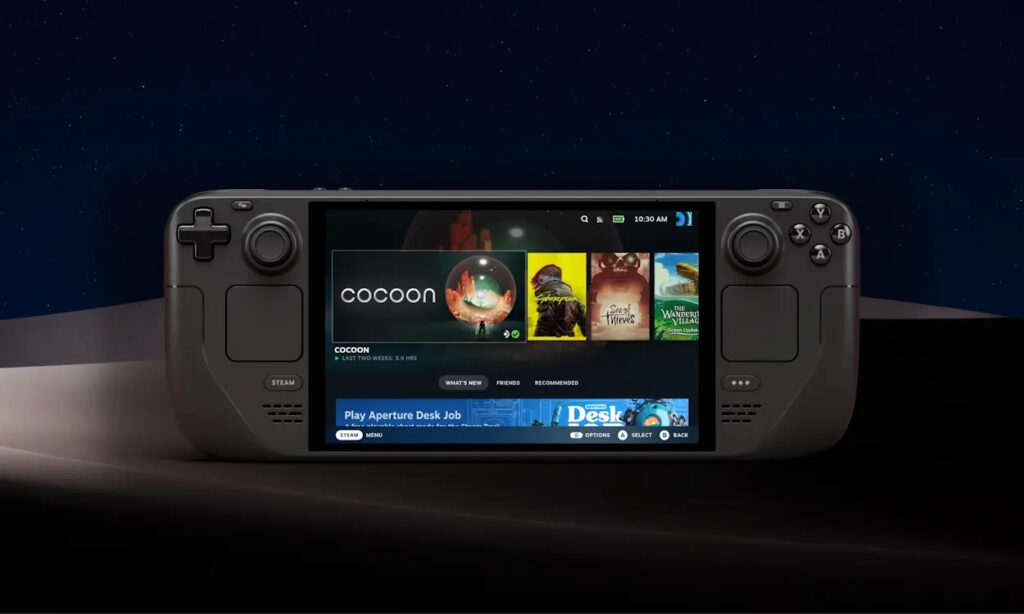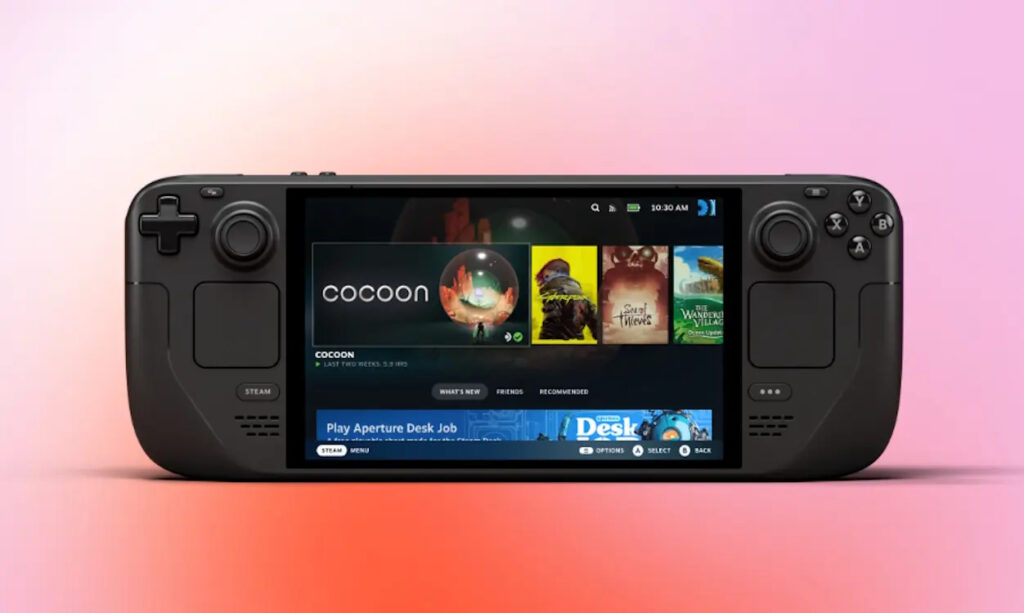
The Steam Deck has become immensely popular among gamers over the past two years, especially after Valve released an upgraded OLED version, featuring improved refresh rates and screen quality for their handheld device. However, anticipation is now mounting for the release of the Steam Deck 2, with gamers worldwide eagerly awaiting more information.
While Valve has not officially confirmed any details about the Steam Deck 2, there have been several leaks and rumors circulating, providing some insight into what to expect. In this guide, we’ll delve into everything we know so far about the Steam Deck 2, helping you stay informed about the latest developments in the gaming world. Without any more delays, let’s delve right into it.
Steam Deck 2: Release Date
The launch of Steam Deck 2 is anticipated to take considerable time, according to an official statement from Valve. Based on available information, Steam Deck 2 is speculated to be released by the end of 2026. This statement from Valve, reported by Bloomberg in late 2023, supports the projected 2026 release date.
Furthermore, a recent rumor from the Chiphell forums also suggests a release window of Q3-Q4 2026 for Steam Deck 2. This aligns with the information provided by Valve to Bloomberg regarding the release date of Steam Deck 2. However, it’s important to approach this rumor with caution.
“Steam Deck 2 won’t be coming for at least another two to three years,” – Lawrence Yang, Product Designer at Valve.

While nothing is set in stone yet, there is a possibility for a 2025 release date for Steam Deck 2. As Valve’s product designer revealed earlier in 2023, “the company is continuously considering the development of Steam Deck 2.“
One theory suggests that once AMD releases the RDNA 4 graphics architecture, Valve may begin work on a new custom APU for Steam Deck 2. This could potentially lead to the release of Steam Deck 2 approximately one year after the launch of AMD’s RDNA 4.
However, Valve may not rush the release of Steam Deck 2 for several reasons. Despite the availability of new processors, the company likely has specific targets and goals it aims to achieve with the next-generation handheld console. We will have to wait and see how Valve decides to proceed with Steam Deck 2.
Steam Deck 2: Pricing (Expected)
As Valve works on the Steam Deck 2, various upgrades are being considered. However, concrete information regarding the price of the Deck 2 is not available, leaving room for speculation. While there haven’t been many leaks regarding pricing, an earlier Chiphell leak suggested that “the price should increase quite a lot.”
To provide context for speculation, let’s examine the launch pricing of previous Steam Deck models. The original Steam Deck was launched at $399, while Valve later introduced the Steam Deck OLED model at $549. The newer OLED model boasts a better and more efficient AMD processor, manufactured on a 6nm process compared to the 7nm process used in the LCD variant.

If the base model of the Steam Deck 2 features an OLED screen, it’s reasonable to anticipate a price of upwards of $500. Assuming Valve maintains similar internal specifications, the cost of upgrading the processor shouldn’t significantly impact the overall price.
Based on these considerations, we speculate that the Steam Deck 2 will likely be priced somewhere between $500 to $600. However, there’s also a possibility that Valve surprises consumers with a lower price point. Following the pattern seen with the first-generation Steam Deck, we may expect to see various console variants with both LCD and OLED screens sold at prices within this range.
Additionally, rumors suggest that Valve will continue to offer lower-end configurations of the Steam Deck. Therefore, it’s likely that the current-generation OLED and LCD variants will remain available even after the launch of the Steam Deck 2.
Steam Deck 2: Specifications
Speculation regarding the expected specifications of the Steam Deck 2 suggests that it will feature one of the best processor architectures available at the time of its release. Here’s the best speculation on what to expect:
The original Steam Deck, launched in early 2022, featured an AMD Aerith APU (accelerated processing unit) built on a 7nm manufacturing process, coupled with RDNA 2 graphics. This graphics architecture was initially introduced with AMD’s RX 6000 series GPUs in late 2020. Additionally, the CPU portion of this custom-built APU on the original Steam Deck is based on the Zen 2 architecture.
For the Steam Deck 2, it’s speculated that it could feature a next-generation APU from AMD built with RDNA 4 graphics architecture, although this has not yet been unveiled by the chipmaker. By the time RDNA 4 is released in the future, it’s possible that Zen 5 architecture could also be available, potentially bringing significant efficiency increases on the CPU side of things.
According to leaks shared on Chiphell.com and previous reports, similar information has surfaced regarding the use of AMD Ryzen Z1 series CPUs on handheld devices like the Lenovo Legion. These Ryzen Z1 series CPUs, coupled with RDNA 3 graphics, are newer than what is currently used in Valve’s first-generation Steam Deck. However, Valve is eagerly awaiting more advanced options for the Steam Deck 2.

Rumors from Chiphell suggested the possibility of incorporating Zen 4 architecture into the Steam Deck 2. However, it’s important to note that RDNA 4 is “merely speculative at this point“. The new APU for the Steam Deck 2 could potentially feature either Zen 4 with RDNA 4 or even Zen 5 with RDNA 4.
Since it’s still early in the development process, Valve may also consider other chipmakers besides AMD for the Steam Deck 2. Recently, we’ve seen OEMs release gaming handhelds based on Intel Core Ultra processors, such as the MSI Claw.
There was a one-year gap between the initial launch of AMD’s RDNA 2 architecture and the release of the original Steam Deck. Currently, AMD’s new RDNA 3 architecture was unveiled in late 2021. However, Valve seems to be waiting for the launch of RDNA 4 instead.
Valve’s decision to wait for RDNA 4 is likely influenced by the anticipated efficiency increases in the next-generation processor, attributed to advancements in the manufacturing process. This aligns with Valve’s expectations for a significant performance leap in the next-generation Steam Deck 2 handheld gaming console, as reported by IGN.
“We are interested in the Steam Deck 2 once we see a significant leap in performance available to us. As of now, we haven’t observed such advancements, so we’re not actively considering the Steam Deck 2,” – Lawrence Yang, Product Designer at Valve.
The chipmaker AMD has introduced technologies like FSR 3 AI-based frame generation, which has the potential to nearly double FPS in games. It is expected that Steam Deck 2 will incorporate this technology, significantly enhancing its capabilities. Additionally, AMD’s FidelityFX Resolution is further optimized by Valve developers specifically for the Steam Deck handheld gaming console.
The Steam Deck OLED already brings various upgrades, and if this console were to feature a better processor, it would essentially serve as a major successor, known as the Steam Deck 2. However, Valve does not currently perceive the available processors as suitable for a generational refresh of the Steam Deck.

Valve’s approach to developing the next-generation handheld aims to provide users with faster performance while maintaining excellent battery life. Therefore, Valve is likely exploring options to balance these aspects effectively in the Steam Deck 2.
Having reviewed the powerful ROG Ally handheld console, I’ve observed that while it offers impressive gaming performance, its battery life falls short compared to the longevity of the Steam Deck. Valve has meticulously engineered the Steam Deck to be highly efficient and well-optimized in managing battery life, and they intend to apply the same principles to the Steam Deck 2.
Valve is waiting for chipmakers to release processors that meet their criteria for efficiency and performance. Once Valve identifies the desired efficiency and performance in the processors available, they will commence work on the Steam Deck 2.
Steam Deck 2: Display Upgrades
The display for the Steam Deck 2 could potentially feature OLED technology. However, considering Valve’s current strategy of offering both LCD and OLED variants for the original Steam Deck, it’s plausible that the base model of the Steam Deck 2 might initially be launched with an LCD display. This could be followed by the introduction of a Premium OLED model.
Valve recently discontinued the 64GB and 512GB variants of the original Steam Deck (LCD variant) after the release of the new OLED variant. Consequently, the LCD variant currently available for sale features 256GB of storage, serving as the entry-level model in the lineup.

Regarding rumors, the earlier mentioned leak from Chiphell also provided insights into the display of the Steam Deck 2. As mentioned in the internal specifications section, the new RDNA 4 graphics architecture expected to be utilized by Valve for the Steam Deck 2 has not yet been released by chipmaker AMD.
It’s still early to confirm whether these details will materialize, but here are the speculated details on the Steam Deck 2 display based on rumors and speculation:
- An upgraded screen resolution of 900p (up from 720p), enhancing clarity and sharpness in gaming experiences. Valve may also consider upgrading to a Full HD (FHD) display.
- An OLED panel offering deep blacks and immersive contrast ratios. If the resolution on Steam Deck 2 increases, the OLED panel may see slight upgrades from the Steam Deck OLED.
- A 90Hz refresh rate, similar to the currently available Steam Deck OLED, enhancing motion clarity in optimal scenarios.
- Possible support for Freesync/VRR (Variable Refresh Rate), although current models do not support it. If included in Steam Deck 2, it would ensure smooth visuals even at lower frame rates.
- High Dynamic Range (HDR) support, akin to the OLED variant of the current Steam Deck. The next-generation Steam Deck 2 handheld could feature improved HDR if the maximum brightness exceeds the 1000 Nits found in the current OLED model.
Overall, the anticipated display of the next handheld from Valve is expected to be impressive, potentially offering a significant upgrade from the base variant.
Steam Deck 2: Design & Controller
The Steam Deck may not be considered old, but with almost two years since its official unveiling, and approaching over four years by 2026, it’s certainly not brand new. The OLED variant received some design enhancements, particularly with a larger screen and reduced bezels.
While there haven’t been any rumors or leaks regarding the design of the Steam Deck 2, speculation suggests that Valve may not make significant changes. The current device’s overall footprint is well-balanced and carefully designed.
Valve aims for improved performance without increasing power consumption, so any new processor in the Steam Deck 2 shouldn’t require additional cooling or result in a thicker device.
It’s likely that the new Steam Deck could weigh between 600-700 grams, similar to the OLED variant, as weight distribution and ergonomics are crucial considerations. Improvements to the controller, such as better thumbsticks, are also anticipated.
Hall-effect joysticks, known for their precision and ease of use, have been featured in recent handhelds like the MSI Claw and ROG Ally. While the current Steam Deck uses potentiometer-based joysticks, it’s unclear if Valve will adopt hall-effect technology for the Steam Deck 2.
Additionally, enhancements to the grip texture of the left and right controller thumbsticks, similar to those seen in the OLED version, may be implemented. This could provide better support and control for gamers, potentially aligning with community mods aimed at improving joystick performance.
Pierre Loup Griffais, who works for Valve in the Steam Deck team, shared several prototypes of the handheld console in the X (formerly Twitter) post. These prototypes vary in design, with some featuring curvier shapes while others are more round. Many of these prototypes appear more aesthetically pleasing than the current Steam Deck, showcasing the possibilities for the Steam Deck 2. However, Valve ultimately settled on the design that we see today.
While the design of the Steam Deck 2 may not deviate significantly from the original model, Valve has the chance to introduce a more visually striking design. The success of the Steam Deck in recent years provides an opportunity for Valve to innovate and create a more captivating handheld gaming experience.

In my opinion, Valve could offer better design customization with the Steam Deck 2. The limited edition Steam Deck OLED demonstrates that different colors and designs can enhance the overall appeal of the device. Therefore, it would be great to see Steam Deck 2 available in various colors and possibly even more customization options.
Steam Deck 2: Battery Size and Life
The original Steam Deck is equipped with a 40 Whr battery, while the new OLED Steam Deck features a slightly larger 50 Whr battery, attributed to the thinner screen. Despite aiming for better performance with the Steam Deck 2, Valve intends to maintain or even improve upon the battery life of the current model.

We anticipate that the Steam Deck 2 will offer “similar battery performance” to the latest model, although this doesn’t necessarily mean an increase in battery capacity. If the processor in the Steam Deck 2 is significantly more efficient, it may allow for similar longevity with a smaller battery size.
A similar trend can be observed in other devices, such as the ROG Phone 8, which features a smaller battery compared to its predecessor, the ROG Phone 7. This reduction in battery size is made possible by advancements in chipset technology, such as the latest Snapdragon 8 Gen 3 chipset. Therefore, it’s possible that the Steam Deck 2 may follow a similar approach.
Considering these factors, Steam Deck 2 might come equipped with a battery size ranging between 40-50 Whr. Regardless of the final size, the gaming battery performance is expected to either match or surpass that of the current models. However, if Valve opts to redesign the chassis extensively, this figure could see significant changes.
And that concludes all the information available about the Steam Deck 2 at present. We’ll continue to update as more details emerge, so stay tuned. What are your personal expectations for the Steam Deck 2? Share your thoughts in the comments below! Let us know in the comments below!

0 Comments